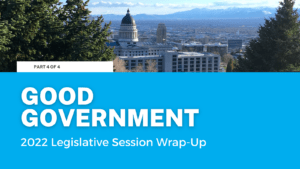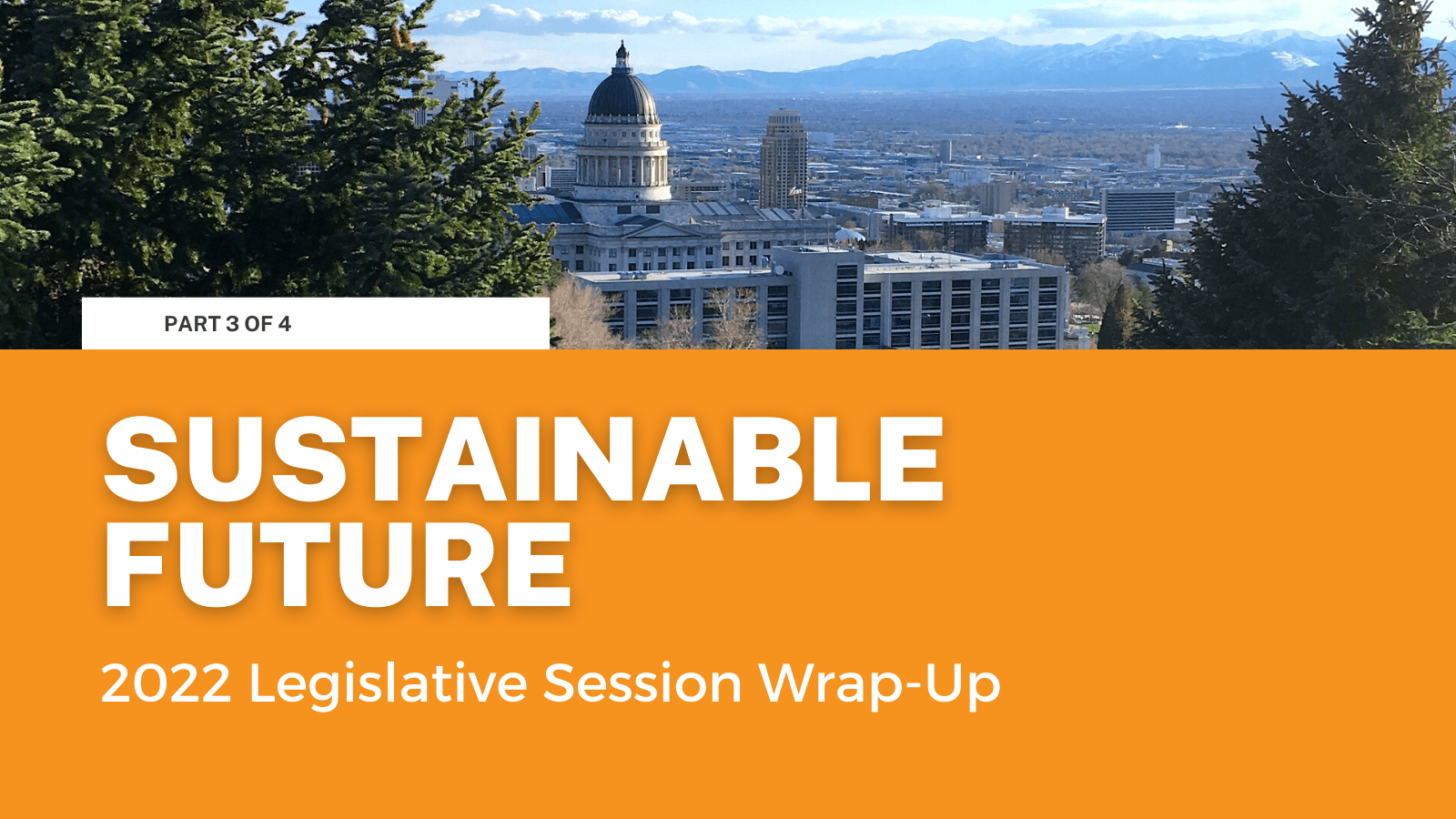This is Part III of a four-part series looking at the good, the bad, and the ugly of the 2022 General Session of the Utah State Legislature. This is by no means a comprehensive guide to the session, but rather a quick glance at the highlights (and lowlights) of what happened this year on Capitol Hill in four categories: Equal Rights, Strong Communities, Good Government, and Sustainable Future.
We all want to live in a world with drinkable water, breathable air, healthy soil for food, and beautiful outdoors where we can live and play peacefully. For over fifty years, Americans have been working to reduce pollution and preserve our environment through highly-effective pieces of landmark legislation, such as the Clean Air and National Environmental Policy Acts of 1970 and the Clean Water Act of 1972. In recent years, Utahns have made meaningful reductions in the harmful levels of air pollution in our state, especially in areas prone to inversions.
A healthy environment is an essential part of every human’s life, and is the foundation upon which the health of current and future generations of Utahns rests. Many state lawmakers have prioritized legislation that will clean up our air or conserve our water, including legislation that passed during the most-recent legislative session, but for too long environmental and climate legislation have been held hostage by politicians and corporations that have prioritized short-term profits and political wins over the long-term health of our environment.
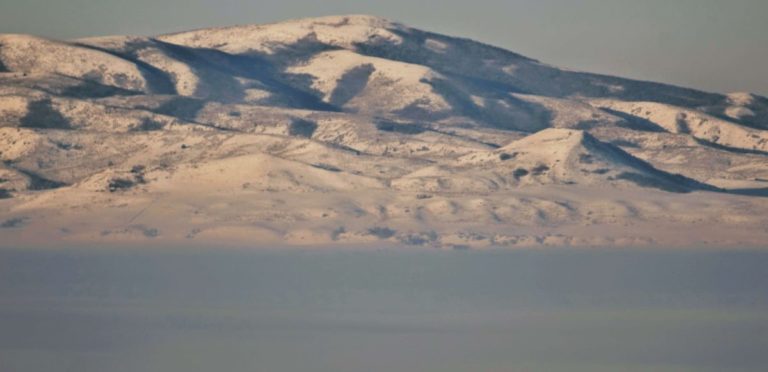
We can and must do more to clean up and prevent pollution, preserve our natural resources, and plan for a more sustainable built environment. Perhaps more importantly, the decisions our leaders make over these next few years in the face of the slow-burning climate crisis will impact those future generations of Utahns to come.
99% of Utah is currently in severe drought, 37% in extreme drought, and another winter with below-average snowpack means less water to go around for the rest of the year. Utah has now been in a “megadrought” for over two decades, the worst drought in over 1,200 years.
From the Great Salt Lake in the north to Lake Powell in the south, we are seeing the impacts of a drier climate on drinking water supplies, local economies, and environmental systems. Toward the end of last summer, three Utah towns ran out of drinking water, while residents, farmers, and businesses had restrictions placed on different types of water uses. Historically low reservoir levels are forcing small recreation business owners to shut down, threatening hydroelectric power generation, endangering migratory bird populations, and putting our own health at risk.
If each legislative session could only be summed up in one word, one of the top contenders this year would be “water.” Lawmakers took significant steps in 2022 toward conserving our water supplies and preserving vital water resources, while also acknowledging there is more that needs to be done in the future.
Utahns use a lot of water, more than any other Western state (248 gallons per capita per day). While it is imperative for each of us to reduce our own personal water consumption, we must also rely upon state and local elected officials to pursue the wide variety of policies that will significantly lower water use. This is especially true when it comes to the largest water consumers in the state, such as the agricultural industry, which uses over 80% of Utah’s water.
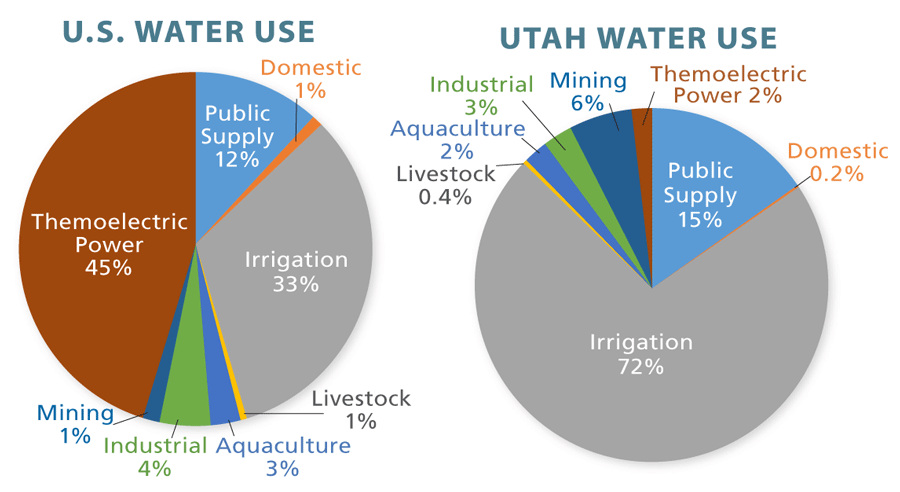
Here are some of the policies that lawmakers placed into law this year as they took some first steps toward addressing water conservation across the state:
- Provided financial incentives for landowners to replace lawns with drought-resistant landscaping, required existing government buildings to reduce outdoor water usage, and restricted the amount of lawns that can be used outside new government buildings (H.B. 121 – Rep. Robert Spendlove)
- Required cities and counties to incorporate water conservation into their general plans by identifying opportunities to eliminate wasting water in municipal operations and reducing water consumption in existing and future development (S.B. 110 – Sen. Mike McKell)
- Required water suppliers to place meters on secondary water connections, imposed penalties on secondary water users that fail to comply with metering requirements by 2030, and provided $200 million in grants to help fund the installation of the required secondary water meters (H.B. 242 – Rep. Val Peterson)
- Gave the holders of water rights the option to temporarily dedicate all or a portion of their water use toward benefiting the environment and wildlife. (H.B. 33 – Rep. Joel Ferry)
These changes to water policy will hopefully begin moving our state in the right direction as we prepare for the likely continuation of drought and water shortages in the years to come. For example, requiring universal metering of secondary water use is expected to significantly reduce water consumption for connections where usage is currently not measured. However, there was more that could have been done this session, as evidenced by a few of the bills that were rejected by lawmakers this session:
- H.B. 115 (Rep. Melissa Ballard) would have required water providers to adopt standards for acceptable levels of water loss within their systems and then establish processes to reduce excessive levels of water loss.
- S.B. 73 (Sen. Jani Iwamoto) would have implemented new standards requiring the use of water-saving toilets, faucets, and shower heads in new construction and remodels.
- H.B. 95 (Rep. Ray Ward) would have prohibited cities and homeowners associations from requiring homeowners to use lawns or turf in landscaping.
Beyond the bills considered during the legislative session, there are many more important policies that state officials should be moving forward that could have far-reaching impacts on the amount of water we use as a state. Changing the way that we pay for water by removing property tax subsidies so that users pay the real price for the water they use would most likely do the most to incentivize water conservation, a proposal that has been pushed for years by the Utah Rivers Council and the Utah Taxpayers Association.
For additional areas that need to be addressed as we seek to be responsible stewards of our precious water resources, check out this recap of the session from the Utah Rivers Council.
While part of the broader legislative focus on conserving water resources, it’s worth pulling out efforts to preserve and restore the Great Salt Lake (GSL) into its own section. Our salty neighbor serves as a popular apocalyptic background for Instagram photos and as the namesake for our capital city. More than a tourist destination, the largest saltwater lake in the Western Hemisphere fills important roles across a number of interconnected environmental and economic systems.
Like many of the reservoirs across our state, the GSL is drying up, most certainly exacerbated by ongoing drought. But unlike those reservoirs, the villain in this story has been the excessive diversion of water for residential and agricultural uses from streams and rivers that would otherwise flow into the lake. Allowing the lake to shrivel up would have severe consequences to the industries that rely on the lake’s unique composition and the wildlife that rely on the lake permanently or as a migratory stopover. Dropping water levels will also expose more of the lakebed to wind, resulting in a growing risk of toxic dust that will place the health of Utahns across the Wasatch Front at risk.
In addition to some of the water conservation bills above, lawmakers passed a few pieces of legislation directly related to the GSL crisis:
- H.B. 410 (House Speaker Brad Wilson) used $40 million as seed money for a trust fund tasked with restoring upstream water flows toward the lake and enhancing the quality of the water basin.
- H.B. 429 (Rep. Kelly Miles) budgeted $5 million toward a comprehensive assessment of the lake and its several watersheds so that policymakers are better armed with data moving forward.
- H.B. 157 (Rep. Timothy Hawkes) requires that all royalties derived from mining of minerals that come from the GSL be used toward managing the lake’s water level. (This is a great policy but it is worth noting that Rep. Hawkes works for the Great Salt Lake Brine Shrimp Cooperative, an association of companies that will benefit from preserving the lake for future resource extraction.)
As with their efforts to more broadly conserve water, lawmakers made some great first steps by passing these bills this session. Lawmakers seem to be taking the issue seriously, especially after the GSL was prioritized by both Governor Spencer Cox and House Speaker Brad Wilson. Lawmakers even took time away from the session to see the impacts of lower lake levels for themselves from the vantage point of Utah National Guard helicopters.

However, these first steps are nowhere near enough to save the GSL and it remains to be seen whether this momentum carries forward into future sessions. We need significantly more funding dedicated to restoring water flows so they reach the lake. We also need state leaders to stop pursuing the Bear River Water Project, an extremely expensive proposal to construct new dams and water pipelines that would prevent even more water from reaching the GSL. And we need to act quickly, before it’s too late to reverse the damage.
Utah Lake was also the source of considerable debate this legislative session as Utahns have largely reacted negatively to a controversial proposal to dredge the lake and use the dredged materials for island development.
Using a 2018 law that allows the state to “dispose” of state lands held in public trust, such as the Utah lake bed, in exchange for restoration and improvements to the lake, the Utah Lake Restoration Project proposes drastically alter the existing ecosystems of the lake and pay for the project by developing the newly-formed islands. Academics and other advocates have spoken up in opposition to the project that is now under review by the US Army Corp of Engineers, claiming a lack of scientific evidence to back up the proposal’s touted benefits, disputing the proposal’s characterization as a “restoration” project, and pointing to existing efforts already underway to improve the lake’s habitats and water quality.
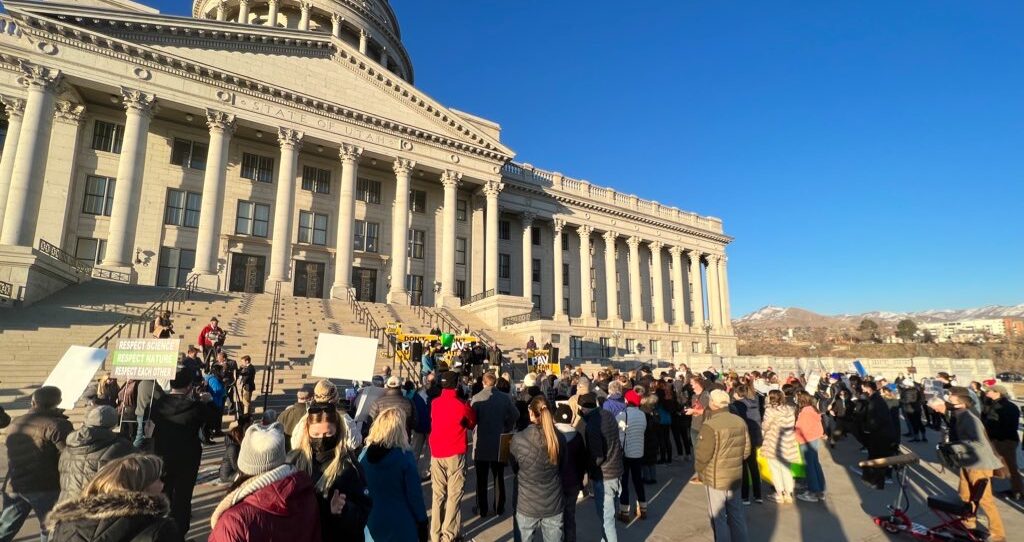
Responding to the proposal from Utah Lake Restoration Project and constituent concerns, lawmakers passed H.B. 240, sponsored by Rep. Keven Stratton, which places additional “guardrails” on the process that would eventually approve or deny the “restoration” proposal. The bill would require that administrative officials make a recommendation that would ultimately have to be approved by the Legislature and Governor, adding additional points of public scrutiny before the project could move forward.
Although expressly unrelated to the proposed Utah Lake Restoration Project, a bill sponsored by Rep. Brady Brammer was caught up in the same public furor. H.B. 232 creates the Utah Lake Authority, a government body similar to the Utah Inland Port Authority or Utah Transit Authority tasked with implementing management plans for Utah Lake, including limited taxing and spending authority. State public authorities have long been used here in Utah as a type of government agency that has direct economic engagement for limited purposes, but have been criticized for lack of accountability and transparency. And while the Utah Lake Authority will not have any role in approving or denying the Utah Lake Restoration Project, some believe the underlying purpose is to serve as a financing vehicle for when the project is approved.
Using funding from the American Rescue Plan Act, lawmakers finally approved a plan to test for lead in the water sources at Utah’s public schools and child care centers. Like me, you may be wondering why this had not already been done a long time ago, especially when lead’s long-lasting negative impacts on child development have been known for decades.
After testing for lead in a sample of Utah schools found trace amounts of lead in 90% of the schools, lawmakers attempted to pass legislation in 2020 requiring testing at every school but the bill didn’t pass due to lack of funding. Thanks to the large infusion of funds from the national pandemic response, lawmakers had the funding to back up their desire to pass H.B. 21 this year, sponsored by Rep. Stephen Handy. However, an alarming number of representatives in the House still voted against the bill.
While each legislative session normally sees several pieces of legislation attacking Utah’s lingering air quality problems, there were only a number of bills that made it into law this year. This could possibly be a result of lawmakers having already addressed many of the “low-hanging fruits,” with more significant policies not attracting the widespread support of lawmakers that represent a wide variety of geographic areas.
With that being said, here are the highlights of the bills addressing air quality that passed or failed this year:
- Passed: S.B. 136 (Sen. Luz Escamilla) requiring a study and recommendations by the Department of Environmental Quality on a plan to reduce diesel emissions, including mitigation projects specifically in and around the Utah Inland Port.
- Failed: H.B. 109 (Rep. Stephen Handy) allowing health care professionals to indicate on a death certificate that air pollution was a contributing factor into the individual’s death, providing greater insight and data into the prevalence of air quality impacts on health and mortality.
- Failed: H.B. 221 (Rep. Suzanne Harrison) creating an income tax credit for the purchase or lease of alternative fuel vehicles.
- Failed: H.B. 275 (Rep. Jeffrey Stenquist) creating a financial assistance program to help individuals purchase lower emissions vehicles.
- Failed: H.B. 332 (Rep. Doug Owens) creating a grant program to help local school districts provide portable air filtration systems in schools.
- Failed: H.B. 405 (Rep. Mike Schultz) requiring the replacement of freight switcher vehicles to those powered by hydrogen-fuel cells or electric batteries by Jan. 1 2028. The bill was pulled from consideration by the sponsor after reaching a deal with Union Pacific that significantly lengthens the time frame and will only cover a small number of the company’s fleet of freight switchers.
- Failed: H.B. 432 (Rep. Ray Ward) requiring the state government to replace vehicles with low- or zero-emission vehicles, when prudent.
After a private developer proposed buying Bridal Veil Falls and building a tram and helipad to transport visitors to the top of the falls, lawmakers took another step this session toward preserving the popular destination located up Provo Canyon. H.C.R. 13, sponsored by Rep. Keven Stratton, approved designating Bridal Veil Falls as a state monument under the management of Utah County. While state monument designation does not necessarily prevent all commercial development, it prioritizes preservation of the area, and Utah County has also placed a conservation easement on the Falls.
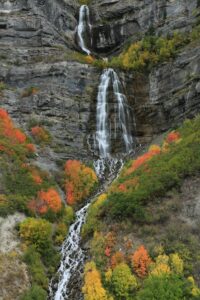
Lawmakers also made changes to the nomination and consideration process for new state monuments. H.B. 27, sponsored by Rep. Steve Eliason, allows for grassroots monument nominations from individuals, nonprofits, tribal entities, historical preservation societies, in addition to government bodies. After a monument is nominated, the bill requires that county and city councils with jurisdiction over the proposed monument be given an opportunity to review the application and indicate whether they support or oppose the proposal. This is most likely a reflection of the oft-repeated talking point from GOP officials in opposition to national monument designations of public lands located in Utah.
Although only a small percentage of the total amount spent on transportation projects, lawmakers invested $200 million in public transit this year by funding improvements to the Utah Transit Authority’s Frontrunner system. The money will be used toward “strategic” additions of a second rail track in areas that will improve reliability of the overall system.
This much needed investment in Utah’s commuter rail system takes advantage of H.B. 322, a bill from Rep. Kay Christofferson that shifts responsibility for large public transit projects from Utah Transit Authority to the Utah Department of Transportation. Lawmakers felt this shift would be useful over the long-term because of UDOT’s history and regular experience with large transportation projects. Support from public transit advocates ranged from enthusiastic to cautiously optimistic, hoping this signals a shift toward lawmakers taking a more active role in funding and expanding public transit moving forward but wanting to wait and see whether lawmakers continue to prioritize highway development with transportation dollars.
A proposal from Rep. Joel Briscoe, H.B. 164, to provide free fares on all of Utah Transit Authority’s public transit modes unfortunately never made it out of committee. The House Revenue and Taxation Committee unanimously voted to hold the bill at the request of Rep. Briscoe, though advocates hope that the success of “Free Fare February” will build momentum toward providing better access for those with low incomes and encourage wider use among the general public.
Keep an eye out for the 2022 edition of our annual Progress Report! Each year, we take all the votes on dozens of bills in four categories–strong communities, equal rights, good government, and sustainable future–and give each lawmaker grades in each category and for their overall commitment to progressive values. The Progress Report is not only useful to better understand how your representative and senator voted during the legislative session, but is a great tool to help inform your vote during election time!
This year’s Progress Report will be released in May at progressreport.betterutah.org.
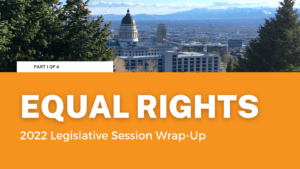
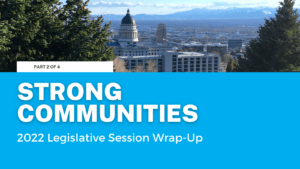
Wrapping up the 2022 Legislative Session: Strong Communities
